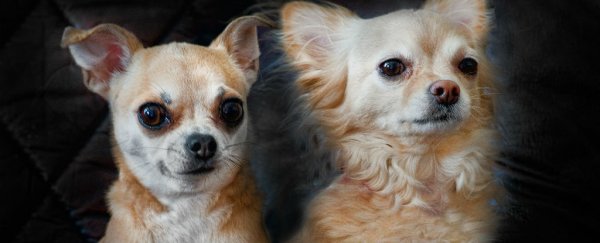Dogs have been our furry companions for thousands of years, but they didn't always look the way they do today. Many well-known dog breeds have changed a lot physically in the last century, thanks to humans.
By identifying specific traits - such as size, coat colour, and demeanour - and allowing only those animals to mate, we've created at least 167 different 'breeds', or groups of dogs with unique physical and mental characteristics (still, they're all part of the same species).
The Science of Dogs blog put together a side-by-side comparison of several popular dog breeds from the 1915 book Dogs of All Nations by Walter Esplin Mason showing what they look like today.
Here are some of the dogs from that list, plus a couple more we found ourselves:
Bull terrier then
 Dogs of All Nations
Dogs of All Nations
The bull terrier was first recognised as a breed by the American Kennel Club (AKC) in 1885. In 1915, it appears to have been a fit, good-looking dog, with a well-proportioned head and slim torso. Dogs of All Nations called it "the embodiment of agility, grace, elegance and determination", and the "gladiator of the canine race".
Bull terrier now
 Jean/http://flickr.com/photos/7326810@N08
Jean/http://flickr.com/photos/7326810@N08
But today, bull terriers are bred to have a football-shaped head and thick, squat body - a far cry from the lean and handsome dog of 1915.
The AKC now states that the dog's face "should be oval in outline and be filled completely up giving the impression of fullness with a surface devoid of hollows or indentations, ie, egg shaped". According to Science of Dogs, it also developed extra teeth and a habit of chasing its tail.
English bulldog then
 Dogs of All Nations
Dogs of All Nations
Few dogs have been as artificially shaped by breeding as the English bulldog. In Great Britain, the dogs were used for bull-baiting - a bloodsport where dogs were used to bait and attack bulls - until it became illegal in 1835. In 1915, the bulldog already had some of the characteristic features we see today, like saggy jowls and a squat stance.
English bulldog now
 flickr.com/photos/tammylo
flickr.com/photos/tammylo
Today, breeders have bred the bulldog to have more pronounced facial wrinkles, and an even thicker and squater body. The AKC describes the ideal dog as having a "heavy, thick-set, low-swung body, massive short-faced head, wide shoulders and sturdy limbs". Sadly, bulldogs suffer from a number of health issues, such as breathing problems and overheating.
German shepherd then
 Dogs of All Nations
Dogs of All Nations
German shepherds have come to symbolise everything from loyalty and companionship to police brutality. The AKC first recognised is as a breed in 1908. In 1915, Dogs of All Nations describes it as a "medium sized dog" weighing just 55 lbs (24 kg), with a "deep chest, straight back and strong loins".
German shepherd now
 Luis Del Rosario/http://flickr.com/photos/ldelros60
Luis Del Rosario/http://flickr.com/photos/ldelros60
But today's german shepherds are bred to be considerably larger (75 to 95 lbs or 34 to 43 kg), with a more sloping back. The AKC describes the ideal specimen as "a strong, agile, well muscled animal, alert and full of life".
However, they are also prone to health problems, such as hip dysplasia, where the leg bones don't fit properly into the hip socket, and bloat, a condition in which the stomach can expand with air and twist, which can sometimes be fatal.
Airedale terrier then
 Dogs of All Nations
Dogs of All Nations
Though you can't tell from this photo, Dogs of All Nations described the colouring of the airedale's head and ears as a rich tan, as well as the legs up to the thighs and elbows. And the dog's coat was "hard and wiry", but not long enough to be "ragged".
Airedale terrier now
 http://flickr.com/photos/melandory
http://flickr.com/photos/melandory
Today, the colour appears not to have changed much, but the fur of modern Airedales definitely looks longer and more "ragged" than it was in 1915 (though why breeders value that now, we can't say). Airedales are considered the largest of all terriers, and are sporting and playful.
Shetland sheepdog then
 Dogs of All Nations
Dogs of All Nations
The Shetland sheepdog, or Sheltie, wasn't recognised by the American Kennel Club until 1911, just four years before the book this image is from was published. At that time, the book reports that it weighed just 7 to 10 lbs (3 to 4 kg), and appears to have had medium-length fur.
Shetland sheepdog now
 Krysta/http://flickr.com/photos/shamesprivacy
Krysta/http://flickr.com/photos/shamesprivacy
Today, the dogs have been bred to be larger, weighing at least 20 lbs (9 kg), though still sleight. And their fur has become unmistakably longer than in 1915. The AKC now describes them as "small, alert, rough-coated, longhaired working dog". They are also very intelligent, and good at herding.
A version of this article was first published in February 2016.
This article was originally published by Business Insider.
More from Business Insider:
